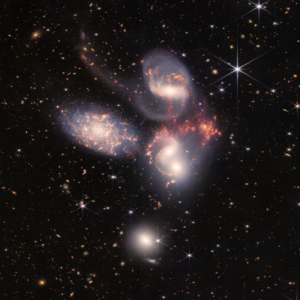The James Webb Space Telescope is an infrared observatory orbiting the Sun about 1 million miles from Earth. The James Webb Space Telescope – also called JWST or Webb – is NASA’s largest and most powerful space science telescope so far. It will study every phase in the history of our universe, ranging from the first luminous glow after the big bang, to the formation of solar systems capable of supporting life on planets like Earth.
JWST is a project of unprecedented complexity. The telescope was launched into an elliptical orbit about the second Lagrange point by a group from the NASA Goddard Space Flight Center and the Northrop Grumman Space Technology. What had initially been proposed as a $1 billion observatory launching in 2007 became a $10 billion project that launched in 2021.
NASA’s James Webb Space Telescope will build on the Hubble Space Telescope’s discoveries. It will usher in a new era in astronomy by gathering information on the universe’s earliest stages, star formation, and whether planets beyond our solar system may be habitable. The orbiting infrared observatory, designed to be about 100 times more sensitive than its Hubble predecessor, was blasted off on December 25 from a site in French Guiana on South America’s northeastern coast. One of the goals of the telescope is to look back through time to when galaxies were young. Webb would do this by observing distant galaxies that are over 13 billion light years away from Earth.
When a telescope looks further away, it is also looking back in time. It takes time for the light the telescope is receiving to travel through space. Therefore, we see objects not as they are now but as they were at the time when they released the light that has traveled for billions of years across the universe to reach us.
To see objects so faint and far away, the telescope needs a giant mirror to collect the light.
The size of a telescope’s mirror area determines its sensitivity, or how much detail it can see. Since the Webb telescope has a much bigger mirror than Hubble, it can look further back in time.
Unlike Hubble, this telescope will not orbit the Earth. Instead, it will orbit the Sun, around 1.5 million kilometers (1 million miles) away from the Earth.
It was said that the first high-quality images can be expected in six months. That being said, we received the first full-color images and spectroscopic dataduring a televised broadcast at 10:30 a.m. EDT (14:30 UTC) on Tuesday, July 12, 2022, from NASA’s Goddard Space Flight Center in Greenbelt, Maryland. The telescope will work for at least 10 years before it runs out of propellant.
We are sharing some of the first images captured by the James Webb Space Telescope, courtesy of NASA.
In the thousand-astronomer team behind the James Webb Space Telescope (JWST) project, a proud member is Lamiya Ashraf Mowla, a Bangladeshi-born astrophysicist.
“This joy is incomparable and I cannot be happier. We will now start analyzing the data to find more details of the galaxies as more pictures will be released soon,” she commented. “I have developed the analysis pipeline to study the structures of the galaxies,” the young scientist explained her function in the project.
This inspirational genius completed her schooling from Willes Little Flower School and College, and then flew to USA to pursue neuroscience in Wellesley College on a fully-funded scholarship.
She went on to achieve her PhD in Astronomy from Yale University, and started working with Dunlap Institute for Astronomy and Astrophysics, the Canadian team working with the JWST, as a fellow in 2020.
